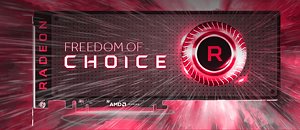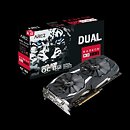Tuesday, April 17th 2018

AMD Responds to NVIDIA's GPP: AIB Partners to Announce New Radeon-Exclusive Brands
In a blog post on its gaming website, AMD has decided to put on the white gloves for a distinctive strike against NVIDIA's GPP initiative, which has seen rivers of ink and public discussion already. In the blog post, entitled "Radeon RX Graphics: A Gamer's Choice", the company is clearly putting its footing on the same stance it always finds itself positioned to by NVIDIA: the freedom of choice, and freedom of standards side of the equation.
The blog post entirely reads as an anti environment-lock manifesto, extorting the virtues of PC gaming and the open-ended building and assembly of parts from various manufacturers that it's built upon. As a move against NVIDIA's decision to enforce their GPP initiative to lock-in AIB partners towards having an NVIDIA-exclusive brand, AMD has come out of the gates saying that the simple solution is for partners to announce new, AMD-exclusive brands as well. This is logical; was to be expected; and is really AMD's only move out of this forced hand it was dealt with.AMD's opinion is written on the walls of its blog post, though: "The freedom to tell others in the industry that they won't be boxed in to choosing proprietary solutions that come bundled with "gamer taxes" just to enjoy great experiences they should rightfully have access to." We've already seen one such brand being announced today by ASUS with its AREZ, AMD-exclusive brand. Others will follow suit, and the only thing NVIDIA will likely be left with is users' opinion on whether exactly this was a required move from the company.
AMD's blog post follows in full:
Radeon RX Graphics: A Gamer's Choice
"Our proud pastime of PC gaming has been built on the idea of freedom. Freedom to choose. How to play the game. What to do and when to do it. And specifically, what to play it on. PC gaming has a long, proud tradition of choice. Whether you build and upgrade your own PCs, or order pre-built rigs after you've customized every detail online, you know that what you're playing on is of your own making, based on your freedom to choose the components that you want. Freedom of choice is a staple of PC gaming.
Over the coming weeks, you can expect to see our add-in board partners launch new brands that carry an AMD Radeon product. AMD is pledging to reignite this freedom of choice when gamers choose an AMD Radeon RX graphics card. These brands will share the same values of openness, innovation, and inclusivity that most gamers take to heart. The freedom to tell others in the industry that they won't be boxed in to choosing proprietary solutions that come bundled with "gamer taxes" just to enjoy great experiences they should rightfully have access to. The freedom to support a brand that actively works to advance the art and science of PC gaming while expanding its reach.The key values that brands sporting AMD Radeon products will offer are:
A dedication to open innovation
AMD works tirelessly to advance PC gaming through close collaboration with hardware standards bodies, API and game developers, making our technologies available to all to help further the industry. Through our collaboration with JEDEC on memory standards like HBM and HBM2, Microsoft on DirectX and Khronos on Vulkan, and through the GPUOpen initiative where we provide access to a comprehensive collection of visual effects, productivity tools, and other content at no cost, we're enabling the industry to the benefit of gamers.
A commitment to true transparency through industry standards
Through industry standards like AMD FreeSync technology, we're providing the PC ecosystem with technologies that significantly enhance gamers' experiences, enabling partners to adopt them at no cost to consumers, rather than penalizing gamers with proprietary technology "taxes" and limiting their choice in displays.
Real partnerships with real consistency
We work closely with all our AIB partners, so that our customers are empowered with the best, high-performance, high quality gaming products and technologies available from AMD. No anti-gamer / anti-competitive strings attached.
Expanding the PC gaming ecosystem
We create open and free game development technologies that enable the next generation of immersive gaming experiences across PC and console ecosystems. These efforts have resulted in advancements such as AMD FreeSync adoption on TVs for Xbox One S or X, integration of forward looking "Vega" architecture features and technologies into Far Cry 5 without penalizing the competition, and inclusion of open sourced AMD innovations into the Vulkan API which game developers can adopt freely.We pledge to put premium, high-performance graphics cards in the hands of as many gamers as possible and give our partners the support they need without anti-competitive conditions. Through the support of our add-in-board partners that carry forward the AMD Radeon RX brand, we're continuing to push the industry openly, transparently and without restrictions so that gamers have access to the best immersive technologies, APIs and experiences.
We believe that freedom of choice in PC gaming isn't a privilege. It's a right."
Source:
AMD Gaming Blog
The blog post entirely reads as an anti environment-lock manifesto, extorting the virtues of PC gaming and the open-ended building and assembly of parts from various manufacturers that it's built upon. As a move against NVIDIA's decision to enforce their GPP initiative to lock-in AIB partners towards having an NVIDIA-exclusive brand, AMD has come out of the gates saying that the simple solution is for partners to announce new, AMD-exclusive brands as well. This is logical; was to be expected; and is really AMD's only move out of this forced hand it was dealt with.AMD's opinion is written on the walls of its blog post, though: "The freedom to tell others in the industry that they won't be boxed in to choosing proprietary solutions that come bundled with "gamer taxes" just to enjoy great experiences they should rightfully have access to." We've already seen one such brand being announced today by ASUS with its AREZ, AMD-exclusive brand. Others will follow suit, and the only thing NVIDIA will likely be left with is users' opinion on whether exactly this was a required move from the company.
AMD's blog post follows in full:
Radeon RX Graphics: A Gamer's Choice
"Our proud pastime of PC gaming has been built on the idea of freedom. Freedom to choose. How to play the game. What to do and when to do it. And specifically, what to play it on. PC gaming has a long, proud tradition of choice. Whether you build and upgrade your own PCs, or order pre-built rigs after you've customized every detail online, you know that what you're playing on is of your own making, based on your freedom to choose the components that you want. Freedom of choice is a staple of PC gaming.
Over the coming weeks, you can expect to see our add-in board partners launch new brands that carry an AMD Radeon product. AMD is pledging to reignite this freedom of choice when gamers choose an AMD Radeon RX graphics card. These brands will share the same values of openness, innovation, and inclusivity that most gamers take to heart. The freedom to tell others in the industry that they won't be boxed in to choosing proprietary solutions that come bundled with "gamer taxes" just to enjoy great experiences they should rightfully have access to. The freedom to support a brand that actively works to advance the art and science of PC gaming while expanding its reach.The key values that brands sporting AMD Radeon products will offer are:
A dedication to open innovation
AMD works tirelessly to advance PC gaming through close collaboration with hardware standards bodies, API and game developers, making our technologies available to all to help further the industry. Through our collaboration with JEDEC on memory standards like HBM and HBM2, Microsoft on DirectX and Khronos on Vulkan, and through the GPUOpen initiative where we provide access to a comprehensive collection of visual effects, productivity tools, and other content at no cost, we're enabling the industry to the benefit of gamers.
A commitment to true transparency through industry standards
Through industry standards like AMD FreeSync technology, we're providing the PC ecosystem with technologies that significantly enhance gamers' experiences, enabling partners to adopt them at no cost to consumers, rather than penalizing gamers with proprietary technology "taxes" and limiting their choice in displays.
Real partnerships with real consistency
We work closely with all our AIB partners, so that our customers are empowered with the best, high-performance, high quality gaming products and technologies available from AMD. No anti-gamer / anti-competitive strings attached.
Expanding the PC gaming ecosystem
We create open and free game development technologies that enable the next generation of immersive gaming experiences across PC and console ecosystems. These efforts have resulted in advancements such as AMD FreeSync adoption on TVs for Xbox One S or X, integration of forward looking "Vega" architecture features and technologies into Far Cry 5 without penalizing the competition, and inclusion of open sourced AMD innovations into the Vulkan API which game developers can adopt freely.We pledge to put premium, high-performance graphics cards in the hands of as many gamers as possible and give our partners the support they need without anti-competitive conditions. Through the support of our add-in-board partners that carry forward the AMD Radeon RX brand, we're continuing to push the industry openly, transparently and without restrictions so that gamers have access to the best immersive technologies, APIs and experiences.
We believe that freedom of choice in PC gaming isn't a privilege. It's a right."



113 Comments on AMD Responds to NVIDIA's GPP: AIB Partners to Announce New Radeon-Exclusive Brands
Acer XF270HU MSRP $599 - Sale $399
Acer XB271HU MSRP $799 - Sale $599
Hmm.. Still a $200 difference
Acer also sells same panels for both FreeSync and G-Sync in 4k 60hz and 34" 21:9 144hz. I'll let you guess on the price difference. Here is a hint, see above
LFC (Low Framerate compensation) isn't built into the panel silly, AMD drivers handle that. In fact FreeSync let's you choose which LFC tech you want to use. You can either use frame doubling (the exact same used with Nvidia G-Sync which is to simply display the same frame again), V-Sync, or nothing.
www.amd.com/Documents/freesync-lfc.pdf
"poor panels "
You do realize that many FreeSync monitors share the same panel as G-Sync monitors right. My Acer XF270hu is exactly the same as it's G-Sync counter part but with no G-Sync module. You are making hyperbolic statements that are all too easy to prove wrong.
"but those are sold at a high price, those are the ones that provide a near identical GSync experience"
Oh really? Did you just assume this? I'm guessing yes, given your previus sentences appear to be void of even rudimentary research. My Acer XF270hu cost $200 less than it's identical G-Sync counter-part. It's not like this is a hidden secret, G-Sync monitors cost on average $200 more than an identical FreeSync monitor. That's not even considering that you can actually get FreeSync monitors under $200 bucks where as you can't find new G-Sync monitors anywhere near that.
Are there lower quality FreeSync panels? Yes but that is simply because FreeSync is so easy to implement that manufacturers can add it on with no cost to themselves. There are more than 10 times the number of FreeSync monitors as there are G-Sync. Is it really so bad if people on a budget get FreeSync as an added bonus? Complaining that there are some lower quality FreeSync monitors is like complaining why anyone but Bugatti bothers making cars. They are great, if you can afford it. If that's your position, you are incredibly entitled.
Regardless, having a range of cheaper FreeSync panels isn't a negative reflection on the technology itself and we should in fact be happy that customers have a wider range products to choose from. Not everyone only want to buy panels certified by Nvidia.
www.tomshardware.com/news/amd-enhanced-sync-framrate-synchronization,35087.htmlOn topic (seriously, why does every AMD/NVIDIA thread devolve into fisticuffs?): it sounds to me like AMD is embracing the new brands NVIDIA forced AIBs to create. Well yeah, AMD is going to work with their AIB partners regardless of branding but AMD bent over and took it instead of fighting it. Not pleased with that. Legal action should be responded with legal action, not counter-marketing.
FTC took 1yr to investigate Intel when AMD filed in that case. If they are going that route it's going to take awhile.As for the marketing. Anyone else find it interesting that the BFG CEO & Nvidia GeForce GTX General Manager now working for AMD made the "A Gamer's Choice" statement. Nvidia still has his blog author page up. He would know how things are played from the opposing side.
They are playing the hand that's been dealt to them.
AMD has a couple of CPU releases in a few hours. That will keep them busy and stir up the usual fisticuffs players in those threads.
Time wise its interestingly humorous if you look at it through Kyles opinion as to why this is happening. Intel & AMD team up with Kaby Lake-G.
Looking back at some of the quotesRemember this involved IBM, HP & Dell, Some who reportedly havent sign on to GPP. So when people dismiss it "it could never happen" they kind of forget it did and even back then you had quotes like thisTake into account that FTC ruling and Larrabee discontinue time since this effected GPUs too.
Now that some of the FTC restrictions are up/expire. Intel partners with AMD and is ramping up their dGPU division with Raja and company. Nvidia doing a turn-about with GPP.
An interesting view point
There are a couple of things to keep in mind with AMD's LFC technology though. First, it is automatically enabled on supported monitors and there is no ability to turn the feature on or off manually. Not usually a big deal - but I do worry that we'll find edge cases where LFC will affect game play negatively, and having the ability to turn this new feature off when you want would help troubleshooting at the very least.
Also, AMD's LFC can only be enabled on monitors in which the maximum refresh rate is 2.5x (or more) higher than the minimum variable refresh rate. Do you have a monitor with a 40-144Hz FreeSync range? You're good. Do you have one of the first 48-75Hz displays? Sorry, you are out luck. AMD has a wide range of FreeSync monitors on the market today and they don't actively advertise that range, so you won't know for sure without reading other reviews (like ours) if your monitor will support Low Frame Rate Compensation or not - which could be a concern for buyers going forward. 4K FreeSync monitors which often have a ~32Hz to 60Hz range will not have the ability to support LFC, which is unfortunate as this is one key configuration where the feature is needed! (As another aside, this might explain why NVIDIA has been more selective in its panel selection for G-Sync monitors; even though they frame double in hardware they still need at least ~2x between the minimum and maximum refresh rates.)
www.pcper.com/reviews/Graphics-Cards/AMD-Radeon-Software-Crimson-Improves-FreeSync-and-Frame-Pacing-Support
I do have to chuckle at these Master and Expert ratings. When known brand supporters have the opposite brand as an Expert, Master, or Champion, I don't think it works. Or when people have crypto expert tagged to them even though they don't have the slightest idea how crypto works.
Lacks LFC: No - AMD has a list of monitors which support LFC. Acer XF270HU does. You also just quoted in post #90 but still say it doesn't. :confused:Is it worth the price premium? If your having that much of a frame discrepancy any kind of VRR ain't gonna help you.
Like myself. I dont want a ryzen desktop for the 8 cores, my 3570k per core is faster then a 4 GHz 1700 in games, which is why I have a desktop. I want a ryzen rig for the NVMe and the extra PCIe 3 lanes.
It doesnt matter if you run intel or AMD, some people will upgrade every year, but most will hand onto the platform until it no longer works, or a new feature comes along. And the toothpaste thing takes a full 40 seconds to fix, its not the end of the world (and as a reminder, AMD now uses that toothpaste on their APUs *sad trombone*)
The end.
Now what are you saying "Their GPU are not that great for gaming to begin with: hot, slow, power hungry. Fact is that the 470 and the 570 are ideal for 1080p.
My recommendation for you is " First get your facts straight then distort them at your leisure"
So it's not a cool card, and it has pretty high power consumption - but it is pretty fast, and a good product overall - but I was expecting better.
On a related subjective note, I've got a Vega 64 and FreeSync monitor... it's the best visual gaming experience I've ever encountered.
As i can see from your system-specs, you have MSI's GTX1080 Aero, ( www.newegg.com/Product/Product.aspx?Item=N82E16814127944 ) which bears a reference-like blower design, so it will have a similar performance with the reference one .
If you look the charts i put ,you'll see that the GTX1080reference can indeed reach 83°C . It's never a good idea to prefer a reference cooling design when you can choose a much better one.